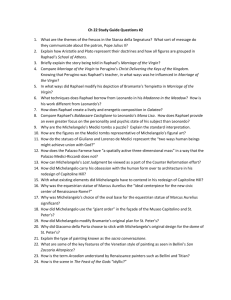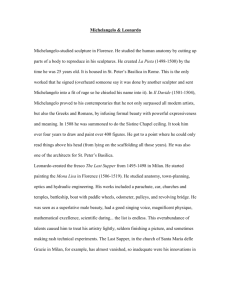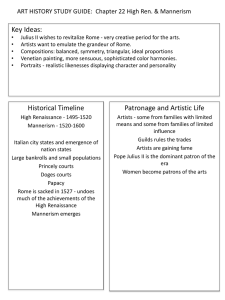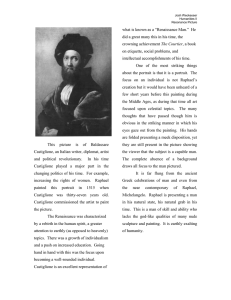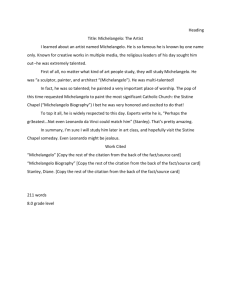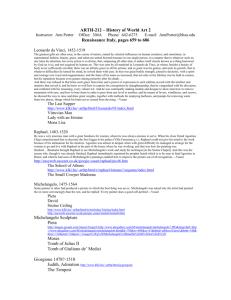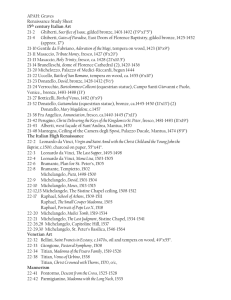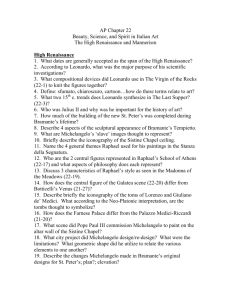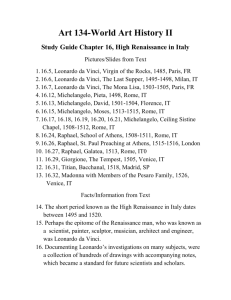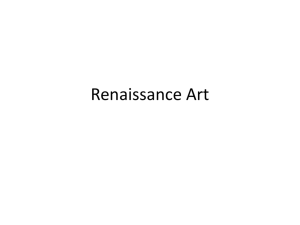HIGH RENAISSANCE AND MANNERISM
advertisement
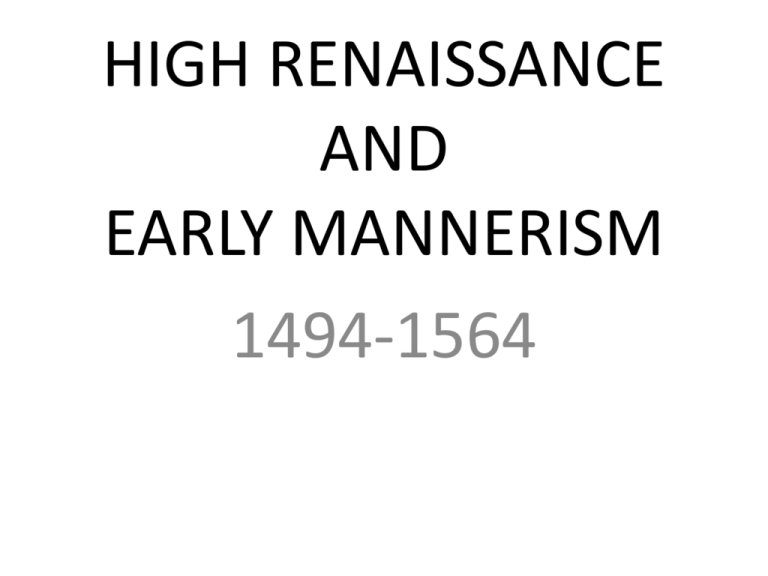
HIGH RENAISSANCE AND EARLY MANNERISM 1494-1564 High Renaissance • 1494-1520 • Classical principles of beauty, balance, order, serenity, harmony, & rational design reached a zenith of perfection • Cultural center shifted from Florence to Rome as popes became the leading patrons – Alexander VI, Pius III, Julius II, Leo X • Humanistic values of Classicism would prevail Politics • France, England, & Spain emerged as powerful sovereign states • France & Spain would dominate European international political life • “Balance of Power” would become a key concept among nations as it had among the Italian City States • Sovereign monarchs gained power, both by divine right, and by practical policies. • Rulers centralized power, with bureaucracies extending jurisdiction into outlying areas. Charles V with a Dog By Titian • 1494- French invasion of Italy as precursor to 35 years of warfare among France, Spain, Holy Roman Empire, Italian City-States, and papacy. • 1527 – Rome was sacked by HRE under Charles V – Raised doubts about Roman control of Italy – Ended arts patronage by popes for a decade • 1529 - Treaty of Cambrai ended war between Hapsburgs & Valois • Only Venice maintained independence, and became haven for artists & intellectuals. Holy Roman Empire, ca 1200 AD POPULATION CHANGES • Movement from rural to urban life • There was an increasing prosperity, but prices rose faster than wages • European population increased – 1400, 45 million – 1500, 69 million – 1600, 89 million Early Mannerism • 1520-1564 • Antihumanistic visions of the world would dominate • Anticlassical • notable for elongated forms, precariously balanced poses, a collapsed perspective, & irrational settings ART • Painters – Leonardo da Vinci – Michelangelo Buonarroti – Raphael (Raffaello) Santi – Titian (Tiziano Vecelli) – Parmigianino • Sculptor – Michelangelo • Architecture – Donato Bramante – Michelangelo – Palladio (Andrea di Pietro) • Literature – Machiavelli, Niccolò – Castiglione, Baldassare – Gaspara Stampa • Music – Willaert, Adrian The Last Supper by Leonardo da Vinci The Last Supper restored Mona Lisa by Leonardo da Vinci The Last Judgement (Sistine Chapel) The Creation of Adam by Michelangelo The School of Athens by Raphael Sistine Madonna by Raphael Balanced pairings of drapes, two figures kneel in prayer, two putti (pudgy human male babies, with wings) The figures and drapes help to frame the Madonna and Child. This is a very balanced composition. Presentation of the Virgin in the Temple by Titian Madonna with the Long Neck by Parmigianino Mixes imagery of pieta along with Virgin holding baby. Sloping shoulders and almost transparent gown like Botticelli Dying Slave M I C H E L A N G E L O David DAVID NAPOLEAN Pietá by Michelangelo Pietá in Florence,a work in progress when Michelangelo died. Tempietto [little temple] in Rome. Designed by Bramante Note the balustrade or circular rail with support posts Bramante rejected the scenographic building style in which buildings were composed of discrete, individual units. Dome of St. Peter’s Basilica in Vatican City Michelangelo used double Corinthian columns (supports) , pilasters, and ribs Villa Capra (Villa Rotonda) in Vicenza, by Palladio Niccolò Machiavelli •1469-1527 •Political writer, concentrated on human weaknesses •Dumped religious and moral rules in writing The Prince •Began modern search for a science of politics Baldassare Castiglione Author of The Courtier •Intended for Italian court society •Composed as a dialogue •Takes place over four evenings •Became the bible for courteous behavior in Europe •Social relations between sexes based on Platonic love •Women to be the educated equals of men Baldassare Castiglione by Raphael Gaspara Stampa •1524-1554 •Wrote using the Petrarchan sonnet to explore love •Asserted the moral worth of the suffering lover •Portrayed the abandoned lover as superior the unresponsive loved one Petrarchan Sonnet Sonnet= 14 line poem in iambic pentameter The octave (1st eight lines) will have the following rhyme scheme abbaabba The sestet may be in any of the following cdcdcd cddcdc cdecde cdeced cdcedc CDDECE in this example "London, 1802" Milton! thou shouldst be living at this hour: England hath need of thee: she is a fen Of stagnant waters: altar, sword, and pen, Fireside, the heroic wealth of hall and bower, Have forfeited their ancient English dower Of inward happiness. We are selfish men; Oh! raise us up, return to us again; And give us manners, virtue, freedom, power. Thy soul was like a Star, and dwelt apart; Thou hadst a voice whose sound was like the sea: Pure as the naked heavens, majestic, free, So didst thou travel on life's common way, In cheerful godliness; and yet thy heart The lowliest duties on herself did lay. Wordsworth Adrian Willaert Flemish musician (1490-1562) •Chapel master at Cathedral of St. Mark’s in Venice •Founder of Venetian school of music •Wrote music for two choirs and two organs, blending the two •Also composed pieces for organ, independent of vocals During this period, a there was the development of consorts, families of instruments ranging in range from low bass to high treble. Typically were viols or recorders. Forerunner of mixed instrumental ensembles and later orchestras.
